Today, I’m giving one of the opening keynotes at the Gilbane Conference, making the case for why marketing technologists are amazing, Neo-like characters in the marketing world equivalent of The Matrix.
The attendees, a 50/50 mix of IT and marketing professionals, are collectively the ideal audience for this. It’s the combination of their talents — increasingly blended into hybrid roles such as marketing technologists, creative technologists, growth hackers, and data scientists — that represents the vanguard of modern marketing.
Here is an annotated version of my slides:
Or, if you’d prefer to read an essay version of my talk:
The Marketing Technologist: Neo of the Marketing Matrix
Let me start with the story of a guy named Mayur.
Mayur started his career as a Java Developer. He was very good, and he was soon promoted. He was then promoted to an Enterprise Architect, managing his own team. He was promoted again, and his responsibilities and team grew. He rose to become a Technical Director, with significant influence and authority over the technology of the business.
Now, take a guess. What was Mayur’s next position? An executive role in software development or IT, perhaps? Reporting directly to the CTO or the CIO?
Good guesses, but Mayur decided to take the “red pill.”
Mayur is the Global Head of Marketing Technology & Innovation at Kimberly-Clark. They own leading brands such as Kleenex, Huggies, and Scott paper products. Mayur works in Marketing and Advertising. Ultimately, he reports up to the CMO.
Not what you expected?
I could have given you a hint that he previously worked at SapientNitro, a leading interactive agency. But before any agency stereotypes colored your perceptions, I wanted to emphasize his technical credentials. Mayur is a bona fide software architect.
So what’s he doing in marketing?
Mayur exemplifies a new kind of marketing professional: a marketing technologist. A marketer who understands technology. A technologist who is passionate about marketing. But why do we need marketing technologists, anyway?
Here’s one big reason:
You may have seen this eye chart of mine. It’s often used to frighten people.
A representative sample of 350 different companies that have built software for marketers. Let me emphasize: this is just sample of a few hundred, from a marketing technology ecosystem of thousands of products.
Marketing automation, CRM, analytics, social media, data management platforms, demand-side ad platforms, search optimization, e-commerce, web sites, landing pages, mobile landing pages, content marketing workflow, gamification — the list goes on.
Assembled in 2012, that diagram is also woefully out of date (it’s grown since then). Yes, there has been some consolidation. But for every acquisition, dozens of new start-ups are still launched. I believe that the scale and diversity of this landscape will continue to grow for the foreseeable future.
Why will it grow? Primarily because the world is changing so rapidly, and it’s changing marketing with it. The possibilities and expectations of customer experience are blossoming around us — disruptive innovation that is now at the very center of marketing. The scale and diversity of marketing itself is exploding.
Software is what enables and harnesses these possibilities. And these days, more people can create software — faster, cheaper, and easier than ever before. It’s a confluence that has sparked a Golden Age of Marketing Software. Marketing has more software solutions available to it today than any other business function in the entire history of computing.
But again, why do we need “marketing technologists” for this? Isn’t this just a different kind of IT?
But this isn’t so much a different kind of IT. It’s more a different kind of marketing.
It’s a digital world we live in now. So many of the experiences we have, so many of the communications we share, are entirely digital. And even those that happen in the physical world are within reach of digital influence in a matter of seconds — in some cases, even milliseconds.
Quick! Reach for your smartphone. (Or just open up a new browser window on the device you’re reading this on.) That’s how quickly you can jack into the digital world, wherever you are, whatever you’re doing.
Here’s the secret for mastering marketing in this digital world — the secret that will give you magical powers like Neo in The Matrix.
Everything digital is controlled by software.
That may seem obvious, but the implications of this are huge. In a digital age, it’s through software that marketing sees and touches the world. Software is marketing’s interface to reality. Our choice of software changes what we can see. Our choice of software changes what we can do.
This is marketing’s “matrix.” Consider the following…
Analytics/attribution software affects our perceptions. How different analytics packages measure events, relate them to each other, and visualize trends and exceptions will color how you perceive your audience.
Marketing automation software affects our processes. The way your marketing automation software was designed, its capabilities, its user interface — what is easy or hard to do — will shape your operations.
Social media listening software affects our engagement. Your choice of social media listening software will influence who and what you pay attention to and how your engage with your audience in different situations.
Customer experience software affects our touchpoints. The creative capabilities of your content management and landing page software will determine what kinds of customer experiences you can deliver across devices. (Forgive me for a quick promotional interlude — but my company, ion interactive, offers amazing software in this category.)
CRM software, by definition, affects our relationships. CRM software impacts how you manage your relationships, offering different ways to structure and harness all the data you collect on your audience. These are decisions that significantly alter the reality of marketing’s matrix.
My point is that the marketing software we choose…
How we configure it…
How we apply it…
How we extend it…
Materially affects what marketing can do.
This is why we should not take the King Solomon approach to dividing marketing technology. The CIO gets the technology half. The CMO gets the marketing half. Not good. The baby does much better in one piece. We need a holistic approach to nurturing marketing technology.
So how do we get there from here?
Some people say this is merely a communication issue between the CMO and the CIO. Yes, getting these two leaders to talk on a regular basis is a good start. But it’s not enough.
Marketing must be able to wield technology as a native capability in its strategy and tactics. (Imagine Neo’s eyes popping open in awe, “I know how to script marketing automation.”) Yet who in the marketing department would know how to develop and manage such capability?
So, imagine a new technical management role in the marketing department that would own this mission — say a chief marketing technologist. (The title isn’t important. It’s the role that matters.)
This marketing technology leader would report up to the CMO, because this is a marketing mission. But he or she would also report with a “dotted line” up to the CIO, because no enterprise technology is an island. This role should be a bridge between marketing and IT.
This role takes responsibility for the technology capabilities of the marketing team: technical people, processes, and platforms. But it also coordinates with IT fully and takes responsibility for adhering to proper IT governance. And by living in marketing, this role helps other marketers get the most out of technology. It’s more than a function — it’s a vehicle for imparting tech culture and intuition to marketing. This role teaches other marketers how to manipulate marketing’s matrix too.
Okay, this is nice in theory…
But do these roles actually exist? According to Gartner, over 70% of large high-tech companies already have someone in this role (although the titles vary). Forrester Research recommended this role as part of a Marketing Technology Office. SiriusDecisions advocates for this role as an integral part of marketing operations. There are many variations on this theme. But all of them share the same core idea: tech-savvy leadership embedded in marketing. (Again, the title isn’t important. It’s the role that matters.)
Of course, this idea scares some people, in both marketing and IT. Is marketing really ready for this?
Let’s consider a graph of technology expertise and technology authority.
If marketing wields too much technology authority without a matching level of expertise, you risk a “cowboy” effect — the IT equivalent of a rogue state. On the other end of the spectrum, a tech-savvvy marketing team that is too tightly restricted by IT policy is a “prisoner.” And if you lack both technical authority and expertise in this digital world, well, you’re in trouble.
The sweet spot is a marketing department that is growing its technology expertise and is given an appropriate level of tech authority to match.
But is native technology expertise really necessary in marketing? It wasn’t before. But the real revolution in marketing is a shift from producing communications to delivering customer experiences. Within the blink of a click, a customer can jump from reading an ad or an email to interacting with us in a digital channel. And the experience they have — good or bad — may be instantly shared, resonating in search and social circles for all time.
This makes customer experiences the definition of our brand.
Technical talent must become native to marketing because to deliver customer experiences in a digital world requires fluency not just with art and copy, but also with code and data. Great experiences fluidly combine these elements from concept to execution. They conceive and raise the baby in one piece.
Code and data are the “star stuff” from which these experiences are crafted — a blend of the software we choose and what we create with it. And the marketing teams who can create the best experiences will rule this marketing matrix.
Of course, not everyone in marketing needs to become a technologist. But technology must entwined into marketing’s DNA, along with storytelling, design, and customer affinity. These are the genes that express marketing in the modern world.
You can still be a great marketer without being a technology savant. (Just like you can be a great engineer without being a marketing wizard.) But you better become really good at collaborating with those who are. Because the line between marketing and engineering is blurring.
It’s inspiring a new generation of professionals who blend both of these disciplines. Marketing technologists. Creative technologists. Growth hackers. Chief Digital Officers. Data scientists. These are not equivalent, but they all share a hybridization of marketing and tech savvy.
These are now many of the hottest positions in business today — they’re in tremendous demand. (Just a hint, if you’re looking for an exciting job with great opportunities.)
Here’s one last reason to embrace marketing technologists…
Technology continues to change exponentially, such as with Moore’s Law. Computational power doubles every two years. Data storage doubles. Social media sites multiply and mutate like fruit flies.
However, we humans don’t change nearly as quickly. Organizations tend to change more on a logarithmic scale. We simply can’t absorb all the technology changes that bombard us at this rate. This leaves us with a gap. How do we decide which changes we should adopt and which ones to forgo?
Marketing in particular feels the strain of straddling this widening gap.
This is one of the key roles that technology leadership must play. Technology management is deciding which changes are adopted. Marketing technologists — especially the role of a chief marketing technologist — can help marketing ride this wave of change, instead of being swept beneath it.
Marketing technologists help marketing regain control of a world that has exploded with complexity and accelerating change. They do this by turning marketing into a “local” instead of a tourist in this new environment. They reveal the secrets of marketing’s matrix.
This marketing matrix has given us a new brand of marketing. And marketing technologists are the Neo-like characters who will help us master it.
Are you ready to take the red pill?

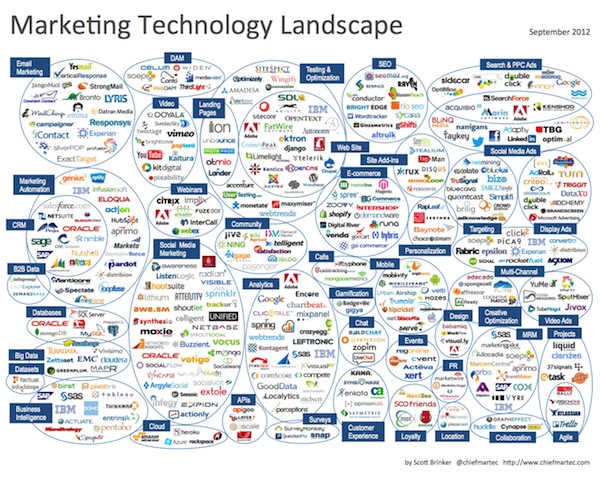
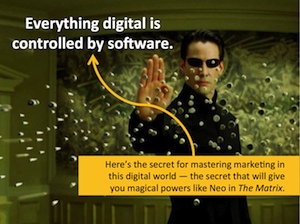

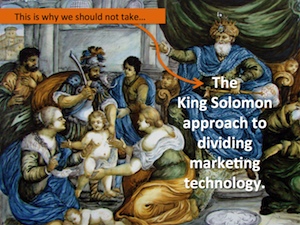
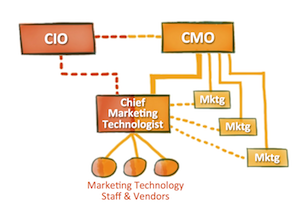
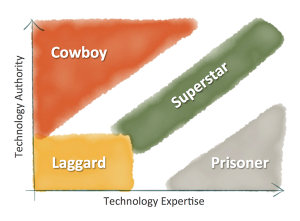
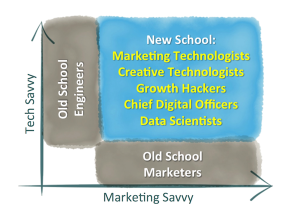
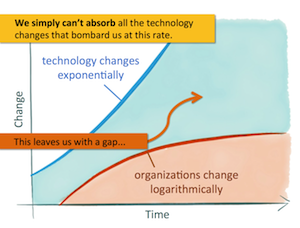
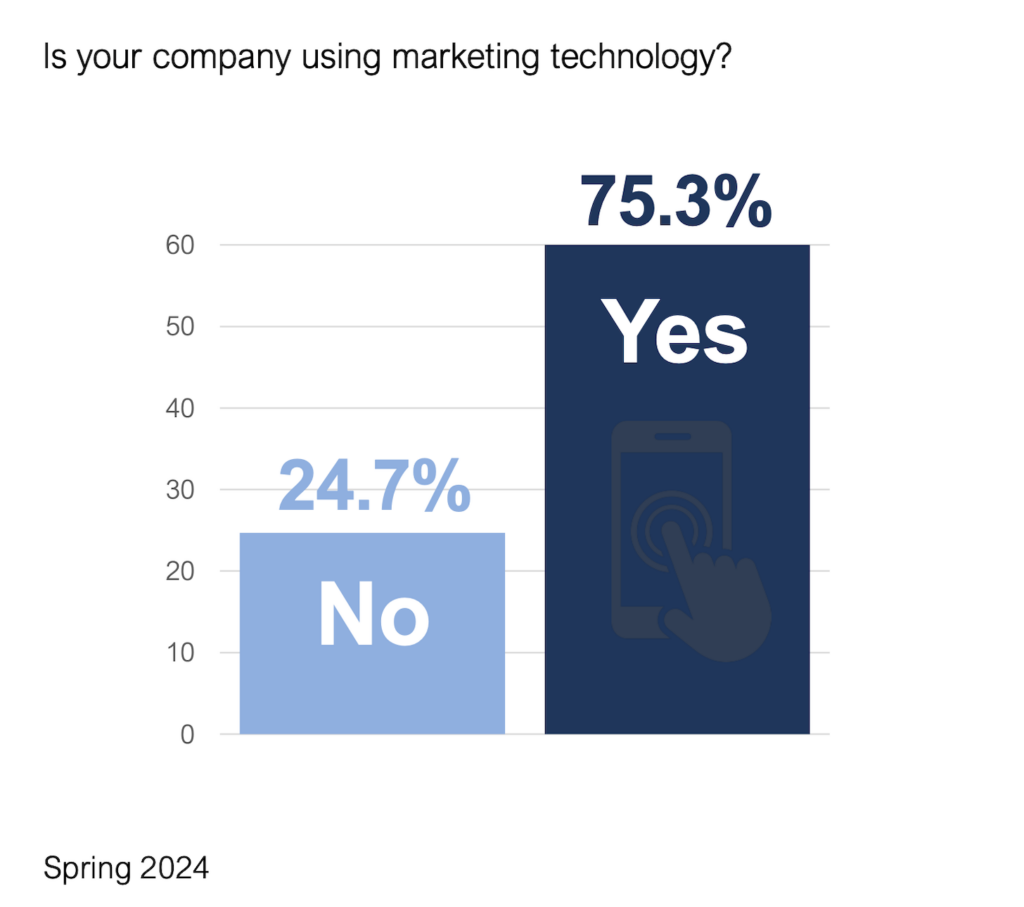

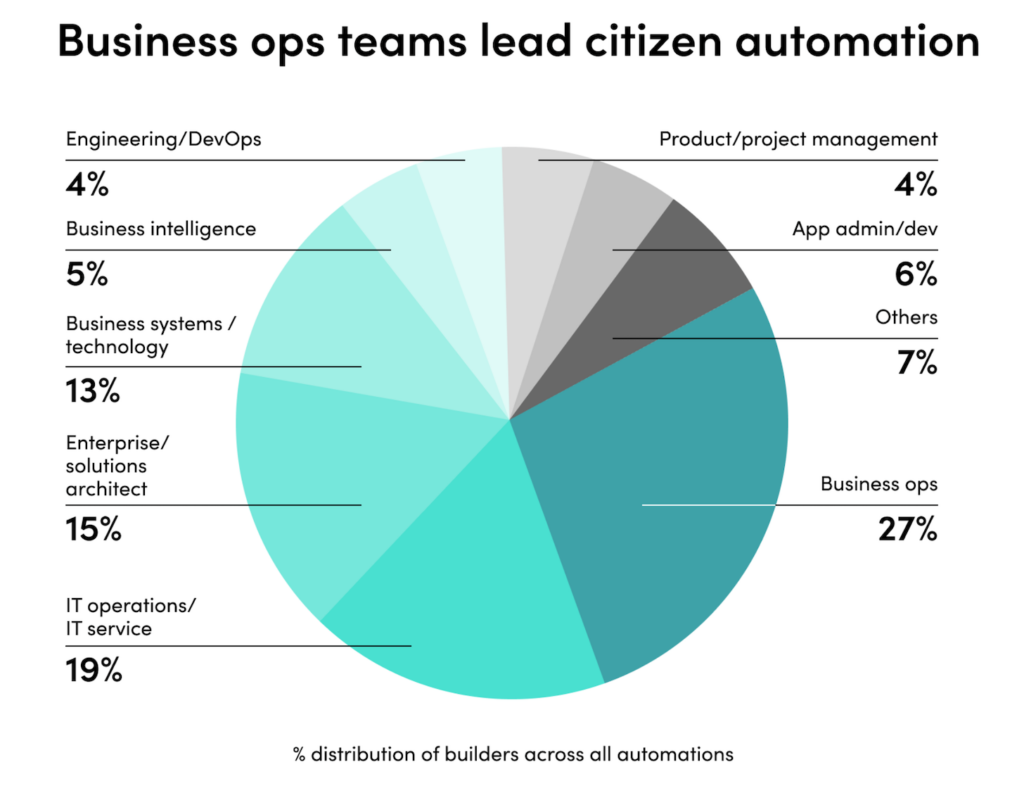
Scott, excellent read and share! As someone who works on the IT and marketing side, it’s wonderful to see this being highlighted. Ive watched the evolution take place over the last few years and the organizations who embrace this, excel rapidly.
Thank you! It is a fascinating evolution to observe.
Phenomenal, I’ll add the companies who don’t understand this mash-up between technology, IT, Innovation and Marketing, will struggle in new digital world. Great post Scott,
Thanks, Michael. It is one of those transformations that is obvious yet fascinating.
Scott,
A terrific articulation of what is emerging as a significant organisational challenge.
Allen Roberts
Thank you, Allen. Where there’s challenge, there’s opportunity! (Okay, that sounds like a fortune cookie.)
Scott – great post thanks! So on the Solomon/baby metaphor… which of IT and Marketing do you see as the most likely to take the moral high ground and cry out “give the baby to her, just don’t kill him”? 😉
Timely post Scott. I work for a smaller organization where I recently came in to play the role of a Marketing Technologist/CMO. We’ve just identified the need for a CIO for a more holistic approach to technology integration across various business processes including marketing.
It seems like we are working backwards but it’s based on very real business needs.
Validates what you mention above.
That’s great to hear, Jacob — thanks for chiming in. Good luck with your tech-CMO mission!
Great article. And as a geophysicist who turn to marketing a short while ago I can only agree…
There is something really cool about a geophysicist moving into marketing. Best of wishes with your journey. Would love to hear more of your reflections on the shift!
Great post Scott. The CMT role has served us well at SAP. We call this our Business Information Officer (BIO). It’s a critical role not just in Marketing but in every key line of business – to help translate our business needs into an enterprise architecture roadmap.
Great post. I always felt I was a kind of hybrid monster because either you are a marketeer, either you are an IT. I just discovered your website and I am not alone anymore. Thank you.
Great slide deck! It articulates what I think is an unheard voice in both the engineering circles and marketing circles.
Hi Scott – great buzz about this and you seem to be an authority on the subject. If I am a traditional marketer, what can I do to gain the same level of experience (or at least understand how to work most effectively) as a marketing technologist? I am already mid-way through my career and with kids, so I am not sure I can go back to school and become an IT specialist anymore…
Scott – how might one tweak the CMT job description to fit a search for such a beast in city government? 🙂